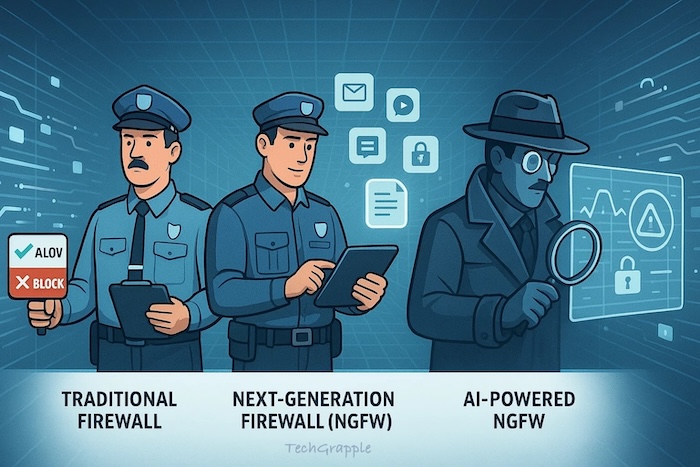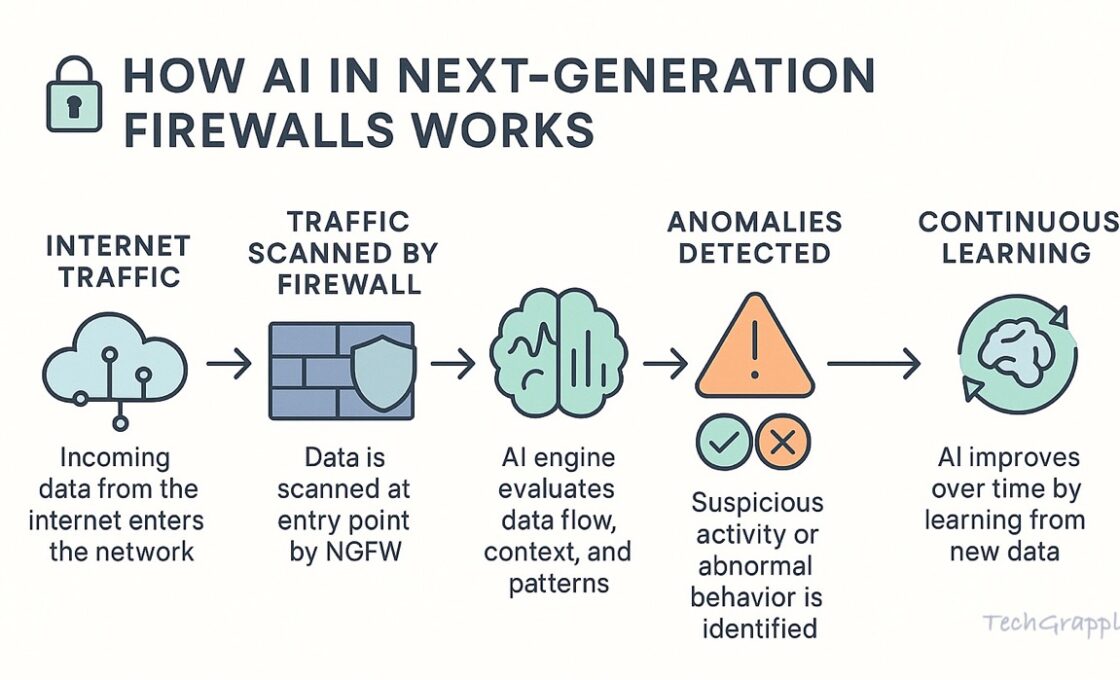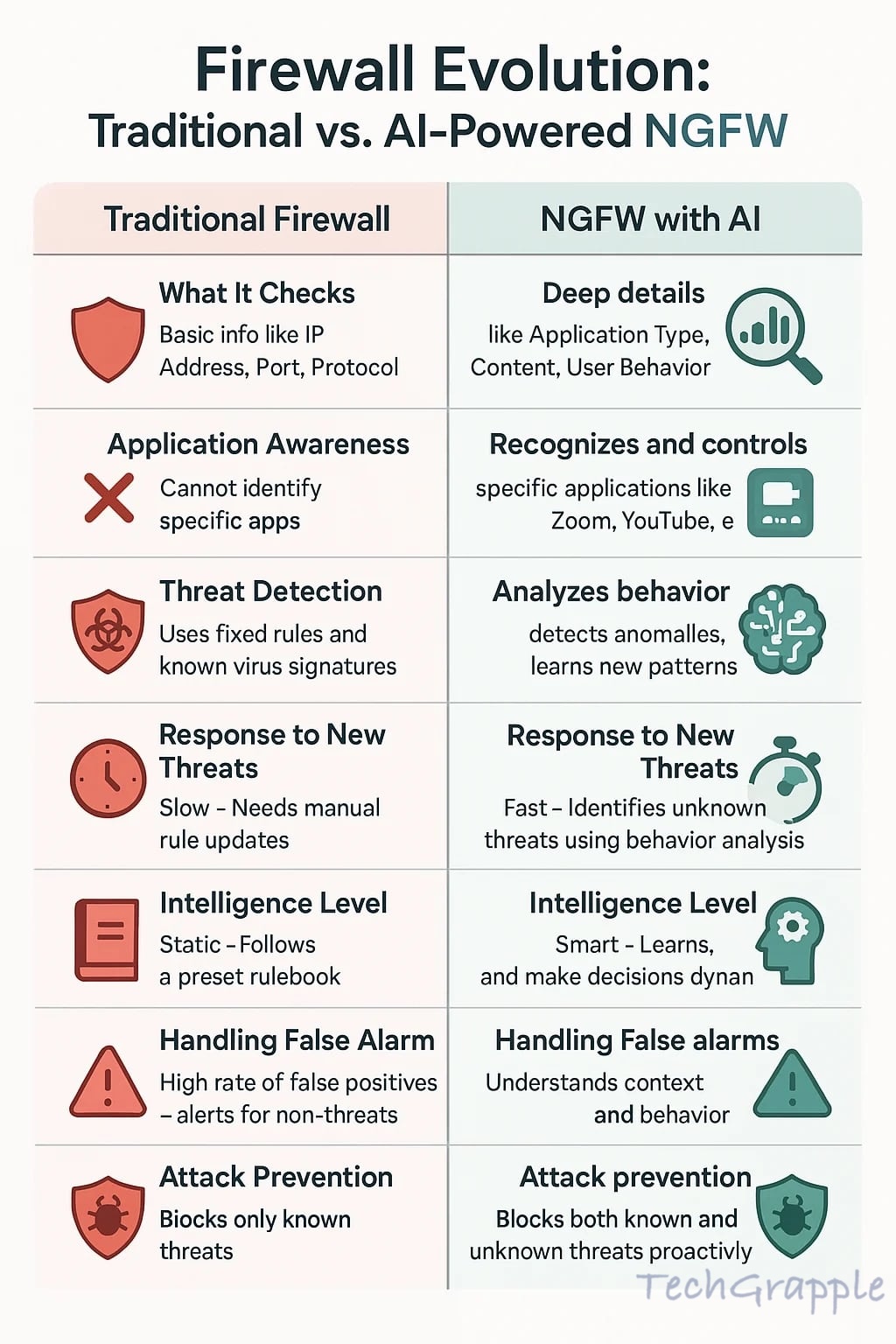AI & Firewalls: How NGFW Is Changing Cybersecurity Forever

Think about keeping your stuff safe online. It’s a big deal, right? We all use the internet for almost everything, but there are definitely sketchy parts and risky things out there. Viruses, folks trying to sneak into your accounts, all that jazz.
For ages, the main tool for online safety has been the firewall. Picture it like a security guard for your internet connection. It stands at the digital doorway and checks who or what is trying to get in or out. Its job is basically to keep the bad stuff away from your computer or your whole network.
The Old Guards: Doing Things by the Book
Imagine that first security guard was pretty basic. Maybe they just had a clipboard with a simple list of rules. Like, “Okay, anyone wearing a blue hat gets in. Green hats? Nope, stay out.” Or, “Nobody leaves carrying a red backpack.” They just followed the instructions they were given.
That’s kind of how the first firewalls worked. They had a set list of technical rules. “Allow info coming from this specific computer address.” “Block anything trying to use this known sneaky route.” They looked at the basic address information on the data packets, checked the list, and made a quick yes/no decision.
This was better than nothing! It stopped some obvious trouble. But the online troublemakers didn’t stand still. They figured out ways to disguise their nasty software or attacks. They learned how to make bad things look like normal internet traffic. Maybe hide a virus inside what looks like a regular file download.
These older firewalls often couldn’t catch these tricks. They’d look at the disguise – “Yep, looks like a file download, the address seems okay, let it through.” They weren’t really designed to look deep inside the package or understand the context of what was happening. Plus, new cyber threats pop up constantly. Someone had to keep updating that rule list on the firewall, and sometimes a brand new attack could slip through before the list got updated. It was a constant game of catch-up.
Getting Wiser: Meet the Next-Generation Firewall (NGFW)
Since the threats got smarter, the defenses had to evolve too. That brings us to the Next Generation Firewall (NGFW). Think of this as a security guard who got some extra training and better tools.
This guard doesn’t just check the basic list anymore. They understand more about what’s going on. They can actually tell the difference between various types of internet traffic. Is this someone just Browse websites? Is it a video call? Is it someone using a specific online game or application? Knowing the difference matters because some activities or apps are naturally riskier than others.
NGFWs can also peek more carefully inside the data packets. They perform what’s called “deep packet inspection.” Instead of just reading the address label, they try to understand the actual content. Is this email attachment really just a document, or is there something harmful hidden inside? Is this website behaving strangely? They look for clues beyond the surface level.
Many NGFWs also include built-in systems to spot and block common attack methods directly, acting like an alarm system that also slams the door shut. This is often called an Intrusion Prevention System (IPS).
So, NGFWs were a solid improvement. They gave security teams more control and better visibility. They could block threats the old firewalls would have missed. But, even with these upgrades, they still heavily depended on knowing what threats looked like. They used big databases of known virus signatures and attack patterns, along with complex rules created by people. They were better, but still struggled with completely new, unseen attacks.
The Real Brain Boost: Enter Artificial Intelligence (AI)

Now, here’s where things get really interesting. What if you could give that smarter security guard an actual brain that could learn and adapt? That’s essentially what happens when Artificial Intelligence (AI) gets added to the mix.
What’s AI, in plain English? AI means making machines that do tasks that people usually handle. It helps computers learn from what they see. They pick up on clues hidden in lots of details. They use these clues to guess what might happen next. They also help solve problems by acting in smart ways.
When you combine AI with an NGFW, the firewall becomes way more powerful and adaptable. It’s like upgrading from a guard with a rulebook and good eyesight to a detective who understands behavior and anticipates trouble. Here’s how AI makes such a difference:
1. It Learns What’s Normal for Your Place
Every network is unique. An office building’s internet use looks different from a university’s, which looks different from your home network. AI is brilliant at watching the traffic flow on a specific network and learning its unique rhythm. It figures out who usually connects, what times are busiest, what kind of data usually gets transferred, which websites are common destinations. It builds a baseline picture of “normal.”
Why does this matter? Because once it truly understands normal, it’s incredibly good at spotting anything abnormal. If a computer that usually only browses the web suddenly starts trying to access sensitive servers it never touched before, the AI flags it instantly. Maybe an employee clicked a bad link, maybe it’s something worse. An older firewall, just checking rules, might miss this subtle shift in behavior. The AI sees it because it deviates from the learned norm.
2. It Catches the Unknown Bad Guys
This is huge. Hackers and virus creators never stop inventing new ways to attack. These “zero-day” threats are dangerous because, by definition, no one has seen them before, so there’s no pre-made signature or rule to block them.
AI offers a powerful defense here. Since it focuses on behavior and patterns rather than just matching known signatures, it can often identify a novel attack. It might see a sequence of actions that looks suspiciously similar to patterns seen in previous, different attacks. Or it might detect network activity that is statistically way outside the norm it has learned. It can raise the alarm saying, “I haven’t seen this exact thing before, but based on its behavior and how it deviates from normal, it looks very risky. Block it!” This allows the firewall to stop threats it hasn’t been explicitly programmed to recognize.
3. It Reacts Super Fast
Online attacks happen at computer speed. A security breach can unfold in seconds or minutes. AI systems can analyze suspicious activity and trigger a defensive action – like blocking the source or isolating a potentially infected machine – almost instantly. This speed is crucial. A human analyst might take much longer to detect, confirm, and then manually respond to the same threat, potentially allowing significant damage to occur in the meantime.
4. It Understands Sneaky, Low-and-Slow Attacks
Not all attacks are loud and obvious. Some are designed to be stealthy. Attackers might try to slip harmful code through in tiny, seemingly innocent chunks over a long period, or probe defenses very slowly to avoid triggering simple alarms. AI, capable of analyzing vast amounts of data over time and correlating small events, is much better equipped to detect these subtle, drawn-out attacks that might otherwise fly under the radar. It connects the dots that simpler systems miss.
5. Less Crying Wolf: Cutting Down on False Alarms
Older security systems, and even some NGFWs without good AI, could sometimes be a bit jumpy. They might flag perfectly legitimate, though unusual, activity as a potential threat. This creates “false positives” – alerts that security teams have to investigate, only to find nothing wrong. It wastes valuable time.
AI learns to tell normal happenings from things that seem off in a given place. It gets good at spotting true issues while ignoring things that do not matter. This way, people in charge of safety can spend more time on real problems and less time checking small, unimportant events.
How This Combo Changes Online Security For Good
Adding AI to NGFWs isn’t just another feature. It represents a major shift in cybersecurity philosophy and capability.
- Going from Reaction to Prediction: Security used to be about reacting to known dangers. Now, with AI, it’s becoming more about anticipating and proactively stopping threats, even unknown ones, based on suspicious behaviors and predictive analysis.
- Handling the Information Tsunami: Today’s internet traffic is a massive flood of data. It’s simply too much for humans to monitor effectively alone, and even basic automated rules struggle. AI excels at processing and finding needles in these enormous digital haystacks.
- Defense Gets Smarter, Not Just Stronger: It’s not just about blocking more things. It’s about understanding why something should be blocked. AI adds that layer of context and behavioral understanding, making defenses more intelligent.
- Learning on the Job: AI models constantly refine their understanding based on new data. The firewall effectively gets smarter and better tuned to its environment over time, adapting to new applications and evolving threats.
- Making Human Experts More Effective: AI takes over the heavy lifting of data analysis and initial threat detection. This frees up human cybersecurity professionals to handle the most complex threats, strategic planning, and incident response where human judgment is essential.

Quick Comparison: Old vs. New Firewalls
Here’s a simple table highlighting the key differences:
| Feature | Traditional Firewall | Next-Generation Firewall (NGFW) with AI |
| What it Checks | Basic info (Address, Port, Protocol) | Deep details (Applications, Content, Users) |
| Understands Apps? | Mostly No | Yes, can identify and control specific apps |
| How it Spots Bad Stuff | Fixed rules, known signatures | Rules, signatures, plus behavior analysis, anomaly detection (AI learns normal) |
| Handles New Threats? | Slow (needs manual rule updates) | Much Faster (AI can spot unknown threats based on behavior) |
| Inspection Depth | Surface-level | Deep Packet Inspection (looks inside data) |
| Intelligence | Follows static instructions | Learns, adapts, predicts (AI capabilities) |
| Blocking Method | Simple blocking based on rules | Advanced blocking, Intrusion Prevention (IPS) |
| False Alarms | Can be high | Generally lower (AI gets better at spotting real threats) |
It’s Not Magic, But It’s Powerful
Of course, AI-powered NGFWs aren’t a magic bullet. They need lots of data to learn properly. The systems themselves are complex and require skilled people to manage them effectively. And unfortunately, the bad guys are exploring AI too, creating a constant cat-and-mouse game.
But the trend is undeniable. AI integrated into our core network defenses like firewalls marks a critical evolution. We’re moving towards security that is less about static gates and more about intelligent, watchful systems that learn, adapt, and react dynamically. These AI-enhanced NGFWs are becoming essential tools, offering a much more robust and forward-looking way to protect our increasingly connected digital lives. They provide that smarter, faster, more insightful guard we desperately need at the digital door.